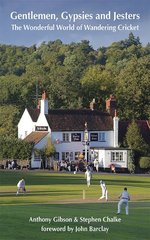Gentlemen, Gypsies and Jesters
Martin Chandler |Published: 2013
Pages: 320
Author: Chalke, Stephen, and Gibson, Anthony
Publisher: Fairfield Books
Rating: 4.5 stars

We must have over 300 reviews on the site by now, very few of which touch upon the game outside the rarefied levels of Test and First Class cricket, and those which do are generally as much concerned with humour as anything else. This is certainly disproportionate, given the substantial numbers of club histories that are published each year, but perhaps only to be expected given the limited market that most of those volumes are aimed at.
So, devoted to the wandering clubs, Gentlemen, Gypsies and Jesters breaks new ground for CricketWeb, and a fine book it is too. The stable that it comes from, Fairfield Books, and its principal writers, Stephen Chalke and Anthony Gibson, will guarantee that it will sell pretty well anyway, but it certainly deserves to be widely read in any event.
There was a time, not so long ago, when club cricket fixture lists, certainly in the south of England, were not dictated by league committments to anything like the same extent as they are now. But the inexorable rise of the leagues in recent years has rather inhibited the scope for the old fashioned wandering clubs, and the traditional games, free of any limits on the length of innings, that they usually aim to play.
Gentlemen, Gypsies and Jesters will reach a wide audience because it does not relate to a single club, and in fact it covers well over a hundred, but even though one or two now have homes to call their own, they are all from that quintessentially English group of nomadic clubs, who jealously guard their often quaint rules, traditions and, as far as they can in the era of the leagues, their fixture lists.
Some of the clubs are very old indeed, and some very large, but not all. After Stephen Chalke’s splendidly paced introduction to the concept I Zingari begin the main list. I Zingari are the oldest and largest club to be featured, and several pages describe their formation, history and eccentricities. In the past some of their fixtures enjoyed First Class status, although not for as long as the Free Foresters, who are another of the well known names who make an early appearance.
Of particular interest to me were the Quidnuncs and the Harlequins, who originate amongst the alumni of the Universities of Cambridge and Oxford respectively. Percy Chapman, a hugely popular figure, famously wore his Quidnunc cap when he captained England in the 1920s. The Harlequin cap was also worn in the Test arena, a couple of years later in Australia, on the head of Douglas Jardine however it was anything but popular. It is perhaps a shame that, having packed his Harlequin cap in his kitbag in 2006/07, Jamie Dalrymple was persuaded, on arriving to reinforce England’s beleaguered party, to leave it there. The two clubs themselves are amongst the oldest of the wanderers, and both have chequered histories, the Quidnuncs in particular spending the best part of a century in suspended animation.
It is important to stress however that the wandering clubs are not merely the preserve of the top class amateur player, and that many clubs play at a much lower level of cricketing ability. One such is the Lords and Commons, comprising players from both sides of the Houses of Parliament and from all parties. There has been the odd quality player, former Prime Minister Sir Alec Douglas-Home having, as Lord Dunglass, played ten First Class matches in the mid 1920s, but he is very much the exception. The photograph on page 34 of the book illustrating the current Shadow Chancellor keeping wicket strongly suggests that he isn’t looking to replace Matt Prior in the England selectors’ plans any time soon.
There are also a number of more modern clubs profiled, examples being Tim Rice’s Heartaches, who were founded in 1973, and the Harry Baldwin Occasionals, who claim a formation date of 1986-ish. There is a closing series of brief essays about clubs who no longer play, but there is no sadness in these, due to the message that is a constant throughout the book. While the men who drive them will inevitably depart this mortal coil, the spirit of a wandering club is not so easily extinguished, the Quidnuncs being by no means the only example of a club having risen again.
Never having taken a great deal of interest in club cricket I was not quite sure what to expect from Gentlemen, Gypsies and Jesters, but I am certainly very glad that I read it. The book appeals on many levels. Naturally given the identity of those responsible for its coming to fruition it is beautifully written, but there must be more to it than that. Perhaps finally understanding a little of what made these pioneering clubs tick, and the social and sporting history that they illustrate helps. Looking at things in the round though I think the key is that there is at least one excellent and entertaining story that emerges from each of these essays. Cricket books, and I include some very good ones in this criticism, are wont to take themselves a tad too seriously on occasion. Gentlemen, Gypsies and Jesters certainly doesn’t, and fully succeeds in its aim to be a celebration of an English institution which, its reader is left hoping, will endure for many years to come.
A further reason to buy the book is that all proceeds from its sale, save distribution costs, will go to the Chance to Shine charity, which promotes cricket in state schools. Copies can be purchased from all good book shops, direct from the publisher or, for those whose country just came runners up in the Ashes, Roger Page.






Leave a comment